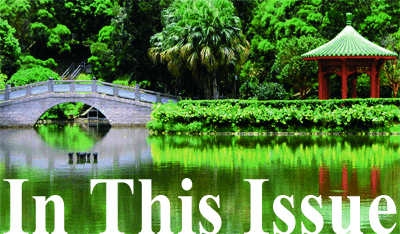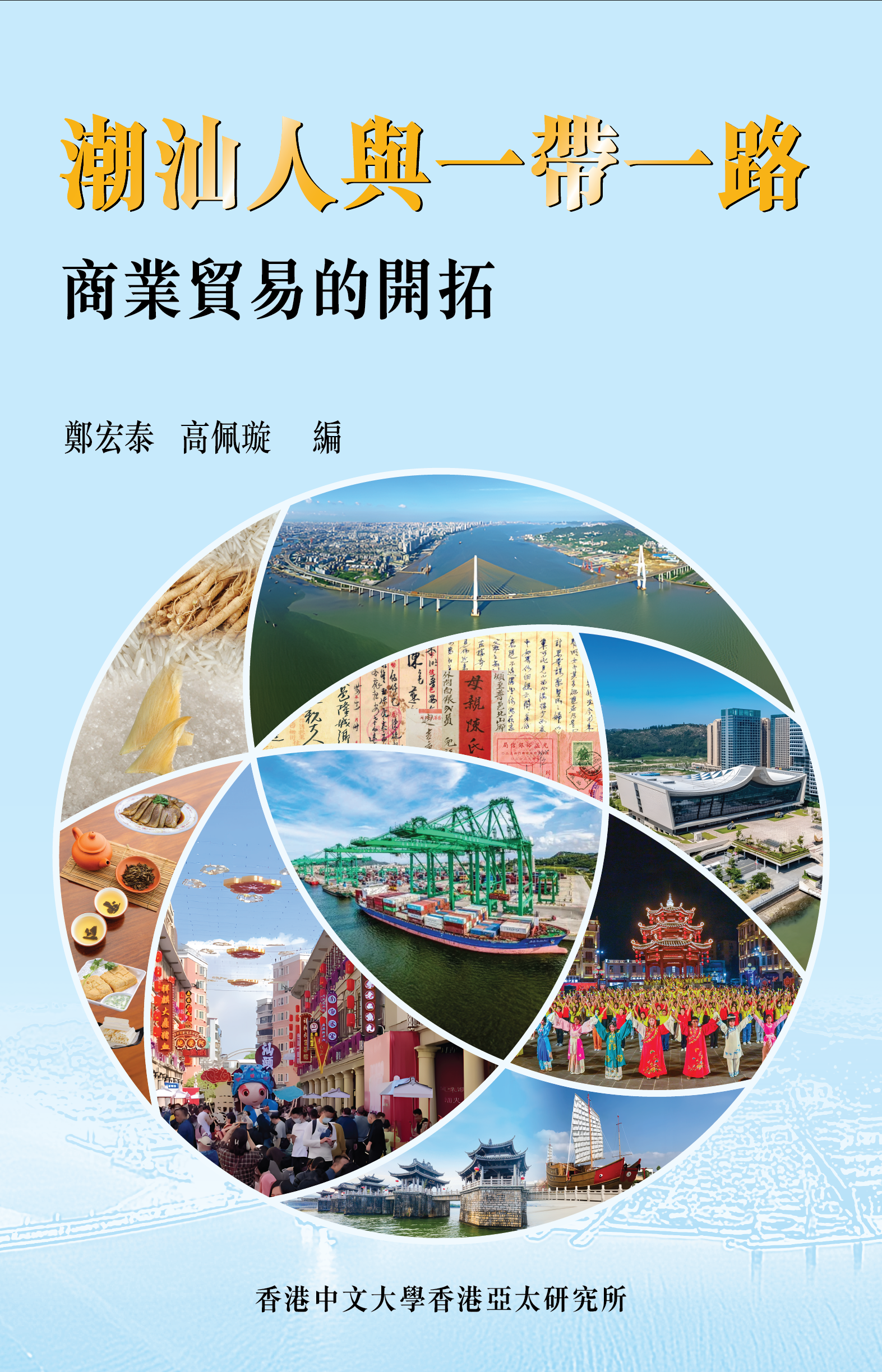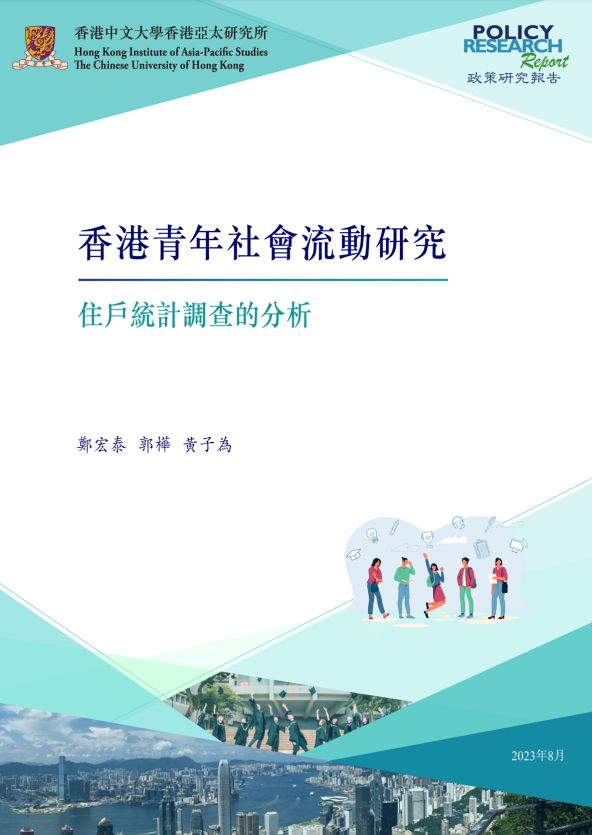
|
| Research | ||
Strategic Research Clusters
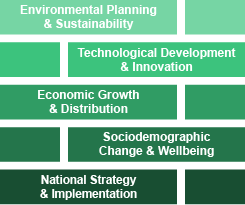 Policy Research @ HKIAPS has identified five closely linked interdisciplinary research clusters to promote academic excellence and social contribution.
Policy Research @ HKIAPS has identified five closely linked interdisciplinary research clusters to promote academic excellence and social contribution.
In the initial phase, we are focusing on research strengths within the Chinese University and on aligning them with the government’s policy priorities and regional development strategies, particularly with the Belt and Road Initiative and the Guangdong-Hong Kong-Macao Greater Bay Area development plan. We will further identify global strategies that are relevant to Hong Kong. ■ |
||
Research Projects * Policy Research @ HKIAPS member
|
||
On Belt and Road Initiative and Greater Bay Area  Report on International Forum on Global Chaozhou People and the Belt and Road Initiative: Background, Documentary, and Policy Recommendation
Report on International Forum on Global Chaozhou People and the Belt and Road Initiative: Background, Documentary, and Policy Recommendation by Federation of Hong Kong Shantou Community Organizations & Policy Research @ HKIAPS |
||
 The Chaoshan People: Opening Up Trade in the Belt and Road Regions
The Chaoshan People: Opening Up Trade in the Belt and Road Regions by Victor W. T. Zheng*, & Pui-shuen Ko |
||
 Hong Kong as International Financial Centre: Challenges and Opportunities
Hong Kong as International Financial Centre: Challenges and Opportunities by Hongling Guan (PI), Yun-wing Sung*, & Terence T. L. Chong |
||
On Health  Effects of a Decision Support Intervention on End-of-Life Care Planning in Patients with Advanced Chronic Obstructive Pulmonary Disease and Their Family Members: A Mixed Method Approach
Effects of a Decision Support Intervention on End-of-Life Care Planning in Patients with Advanced Chronic Obstructive Pulmonary Disease and Their Family Members: A Mixed Method Approach by Helen Y. L. Chan (PI)*, Carmen W. H. Chan Yip, Vivian W. Lou, Pete Wegier, Jean Woo*, & Jacqueline K. Y. Yuen |
||
On Youth  The Social Mobility of Young People in Hong Kong: An Analysis Based on Household Surveys
The Social Mobility of Young People in Hong Kong: An Analysis Based on Household Surveys by Victor W. T. Zheng*, Hua Guo*, & Kevin T. W. Wong |
||
On Belt and Road Initiative and Greater Bay Area
Report on International Forum on Global Chaozhou People and the Belt and Road Initiative: Background, Documentary, and Policy Recommendation Investigators: Federation of Hong Kong Shantou Community Organizations & Policy Research @ HKIAPS Funding source: Federation of Hong Kong Shantou Community Organizations  This report integrates the speeches delivered by scholars and experts who participated in the “International Forum on Global Chaozhou People and the Belt and Road Initiative”. Incorporating relevant background and information, the report proposes five policy recommendations for constructing an innovative model of cooperation for the Belt and Road Initiative: Enhancing policy communication, promoting infrastructure connectivity, facilitating trade, leading financial connectivity, and fostering people-to-people bonds. These suggestions are intended as references for the Hong Kong government (the Government).
This report integrates the speeches delivered by scholars and experts who participated in the “International Forum on Global Chaozhou People and the Belt and Road Initiative”. Incorporating relevant background and information, the report proposes five policy recommendations for constructing an innovative model of cooperation for the Belt and Road Initiative: Enhancing policy communication, promoting infrastructure connectivity, facilitating trade, leading financial connectivity, and fostering people-to-people bonds. These suggestions are intended as references for the Hong Kong government (the Government).
To enhance policy communication, the report recommends that the Government establish a dedicated mechanism to effectively communicate with governments of the regions along the Belt and Road. Additionally, the report suggests organizing training programmes for young diplomats and government administrators in Belt and Road regions. In order to promote infrastructure connectivity, the report proposes that the Government encourage active participation from the engineering sector in the construction of infrastructure. To facilitate smooth trade, the report recommends that the Government increase support measures, such as providing project loans or bank guarantees to the business sector. In leading financial connectivity efforts, the report suggests that the Government examine various financial regulatory systems and position Hong Kong as a financing platform for the Belt and Road Initiative. Additionally, the report emphasizes the importance of enhancing the usage and coverage of the renminbi in Belt and Road countries. To foster robust people-to-people bonds, the report advocates increasing funding for student exchanges and study programmes in countries along the Belt and Road. In addition to summarizing the suggestions put forth during the forum and providing comprehensive recommendations to the government, the organizers have reached a consensus on three significant matters. These serve as guiding principles for future long-term endeavours. First, the focus will be on Chaozhou-Shantou people. Second, the emphasis is on adhering to the theme of the Belt and Road Initiative. Lastly, the integration of academia with policy, employing a forum model that encompasses regional and international perspectives, is highlighted. |
||
The Chaoshan People: Opening Up Trade in the Belt and Road Regions Investigators: Victor W. T. Zheng*, & Pui-shuen Ko Funding source: Federation of Hong Kong Shantou Community Organizations  The Chaoshan region is a homeland of overseas Chinese and one of the main ancestral homes of compatriots from Hong Kong, Macau, and Taiwan. The people of Chaoshan have a pioneering spirit and have been the forerunners and builders of the Belt and Road Initiative. They primarily embarked on overseas journeys via Hong Kong for livelihood and business reasons. Not only did they export Chinese agricultural, mining techniques, handicrafts, and culture overseas, but they also absorbed novel foreign elements and brought them back to China, becoming a bridge connecting their hometowns with the global community, with Hong Kong serving as a central hub.
The Chaoshan region is a homeland of overseas Chinese and one of the main ancestral homes of compatriots from Hong Kong, Macau, and Taiwan. The people of Chaoshan have a pioneering spirit and have been the forerunners and builders of the Belt and Road Initiative. They primarily embarked on overseas journeys via Hong Kong for livelihood and business reasons. Not only did they export Chinese agricultural, mining techniques, handicrafts, and culture overseas, but they also absorbed novel foreign elements and brought them back to China, becoming a bridge connecting their hometowns with the global community, with Hong Kong serving as a central hub.
The Chaoshan People: Opening Up Trade in the Belt and Road Regions, edited by Victor W. T. Zheng and Pui-shuen Ko, delves into the realm of commerce, exploring the remarkable journey of Chaoshan people as they navigate the Belt and Road initiative. With Hong Kong as their initial launching pad, this book examines the profound impact that they have had on cross-regional trade cooperation and social interactions. The book is divided into three sections: “Depicting the Cultural Landscape,” “Constructing Socio-economic Networks,” and “Running International Trade.” The first section, “Depicting the Cultural Landscape,” begins with Prof. Chunsheng Chen’s article, “The Chaoshan People Going Global: History and Culture”, which examines the cultural characteristics of Chaoshan businessmen and compares them with businessmen from other regions in China. Following this, Prof. Takeshi Hamashita presents his work on “Asia’s Maritime Trade Circle and the Chaoshan Business Network: A Discussion Based on Tsung-i Jao’s Compilation of ‘The Gazetteer of Chaozhou’”, in which he analyses the significance of Chaoshan businessmen in the Asian maritime trade bloc based on the famous compilation by Prof. Tsung-i Jao. Next, Prof. Chak Yan Chang’s essay, “How Did Chaoshan Culture Take Root and Thrive?”, explores Chaoshan culture through the lens of German philosopher Hegel’s theories on civilization and culture. The last chapter, titled “Chaoshan Ancestors in Cuba” and written by Prof. Kin-sheun Louie, delves into the history of Chaoshan coolies in Cuba during the 19th century. The second section, “Constructing Socio-economic Networks”, comprises four chapters. The first chapter, “From Qiaopi Trade to Belt and Road: The Construction and Transformation of the Chaoshan Business Network in Southeast Asia”, by Dr Huimei Zhang and Prof. Hong Liu, focuses on Chaoshan businessmen in Singapore and their trading network in Southeast Asia. Prof. Pui-tak Lee then presents “Industrial Chain and Ethnic Networks: The Rise of Hong Kong’s Chaoshan Businessman Po-shan Liu from 1948 to 1960”, a discussion of how Po-shan Liu developed his business through close relationships with the Chaoshan community in Hong Kong. Lastly, Dr Joseph W. W. Chan explores the history of Chaoshan people in Indonesia in his essay “Indonesian Chaoshan People along The Maritime Silk Road and China-Indonesia Economic Cooperation”. The final section, “Running International Trade”, features Prof. Chi-cheung Choi’s presentation on the “Rice Trade and the Transaction Network between Hong Kong, Singapore, Thailand, and Shantou,” which traces the roots of the present-day Belt and Road Initiative. Additionally, Prof. Gordon C. K. Cheung and Prof. Chak Yan Chang discuss “Chaoshan People and the Operation and International Trade of the Hong Kong Shark Fin Industry”, shedding light on the rarely discussed participation of Chaoshan people in the industry. Prof. Guanmian Xu investigates a dispute over the taxes on Chaozhou sugar exported to Northern China in his article “Selling Chaozhou Sugar to the North and the Warehouse Case in the Early Republican Era”. Lastly, in their article “Chaoshan Businessmen and the Development of the Chinese Medicine Industry in Hong Kong”, Dr Yuk-sik Chong and Dr Victor W. T. Zheng explore the history of Hong Kong as an entrepot for Chinese medicine and the contributions of Chaoshan businessmen in this field.
|
||
On Economic
Asset Protection and Legal Entities Investigators: : Travis K. H. Ng (PI)* Funding source: Hong Kong Research Council – General Research Fund  Many businesses use a variety of asset protection strategies, strategies aiming at protecting both tangible and intangible assets against business liabilities. Those effective can deter claimants ex ante and prevent losing assets ex post after a judgement. It is common to use entities such as corporations and LLCs to hold assets, while run different risky business activities under separate entities that act like “silos”. Courts usually respect their deliberate use of legal structures to avoid incurring in liabilities so long as they are set up properly well before liabilities occur.
Many businesses use a variety of asset protection strategies, strategies aiming at protecting both tangible and intangible assets against business liabilities. Those effective can deter claimants ex ante and prevent losing assets ex post after a judgement. It is common to use entities such as corporations and LLCs to hold assets, while run different risky business activities under separate entities that act like “silos”. Courts usually respect their deliberate use of legal structures to avoid incurring in liabilities so long as they are set up properly well before liabilities occur.
Understanding asset protection helps us understand the legal structure of a firm and the ways businesses are conducted in real world. These legal structures cannot be explained by the typical theories of the firm in economics that focus on the scope of control because under a fix scope of control, a firm can legally structure itself in a number of ways. Legal scholars have written about how businesses organize their legal structure but some key economic questions remain unanswered. Economists on the other hand do not pay much attention on the legal structure of a business. Our premise is that legal structure creates real economic values in some situations. However, an elaborated legal structure neither eliminates risk nor comes without costs. Under what conditions a business would prefer an elaborated legal structure? What benefits and costs such a legal structure bring to the business? If risk does not get eliminated, how would doing so shift the risk across parties? How would legal structure affect firms’ capitalization and financing decision? What sorts of incentive problems a more elaborated legal structure create? How would a business’s legal structure affect its relations with its potential customers? Our proposal first highlights some stylized facts to show that many businesses are organized under elaborated legal structures. We suspect beyond getting around some legal hurdles, organizing businesses in a particular legal structure brings real economic values. We propose a model to view the issue, which admittedly, needs to be further developed to address the more ambitious questions we seek to investigate. We describe the investigative, empirical, and theoretical approaches we will take to address our research questions. We aim at comparing our theoretical results with those written in the literature. |
||
Hong Kong as International Financial Centre: Challenges and Opportunities Investigators: Hongling Guan (PI), Yun-wing Sung*, & Terence T. L. Chong Funding source: Institute of Guangdong, Hong Kong and Macao Development Studies, Sun Yat-sen University, China  The Project covers the longitudinal development of Hong Kong as an IFC (International Financial Centre), and the horizontal comparison of Hong Kong with other major IFC’s in terms of various indicators. The strengths and weaknesses of the major subsectors (stock market, bond market, wealth management, and professional services) are then examined. External challenges (US-China rivalry, Ukrainian war and contractionary monetary policy to fight inflation, Covid epidemic), internal challenges (emigration of talents, exodus of multinationals, and systemic risks), and opportunities (digital currency, fintech, Belt and Road initiative) are analysed in detail.
The Project covers the longitudinal development of Hong Kong as an IFC (International Financial Centre), and the horizontal comparison of Hong Kong with other major IFC’s in terms of various indicators. The strengths and weaknesses of the major subsectors (stock market, bond market, wealth management, and professional services) are then examined. External challenges (US-China rivalry, Ukrainian war and contractionary monetary policy to fight inflation, Covid epidemic), internal challenges (emigration of talents, exodus of multinationals, and systemic risks), and opportunities (digital currency, fintech, Belt and Road initiative) are analysed in detail.
|
||
On Education
Three Decades of Educational Mobility Investigator: Dongshu Ou (PI)*, & David M. Post Funding source: The Hong Kong Association of the Heads of Secondary Schools Limited  The persisting associations between parents’ educational attainment and children’s educational outcomes have been well documented in the developed world, although until recently the literature was primarily focused on such persistence form fathers to children. The role played by mothers in their children’s education has been increasingly recognized in the study of intergenerational social mobility studies. However, there is still too little research on intergenerational education mobility in Hong Kong, and thus, we also have limited knowledge about the prospects for girls to raise their socio-economic status through education.
The persisting associations between parents’ educational attainment and children’s educational outcomes have been well documented in the developed world, although until recently the literature was primarily focused on such persistence form fathers to children. The role played by mothers in their children’s education has been increasingly recognized in the study of intergenerational social mobility studies. However, there is still too little research on intergenerational education mobility in Hong Kong, and thus, we also have limited knowledge about the prospects for girls to raise their socio-economic status through education.
In addition, existing studies did not provide consistent evidence that educational expansion policies have reduced the association between parents’ and children’s schooling, nor have studies examined the impact of Hong Kong’s education expansion reforms on intergenerational educational mobility. Further, of special importance for mobility researcher in Hong Kong are second-generation Mainlander immigrants constitute a large proportion of Hong Kong’s population, little is known on their intergenerational social mobility and the impact of educational expansion reforms on their mobility. Using Census data from 1991 to 2021, this proposal would allow the investigators to provide a comprehensive analysis of intergenerational education mobility in Hong Kong over a period of three decades, investigate the heterogeneity in intergenerational transmission of human capital in gender and immigration background, and assess the impact of educational reforms on intergenerational mobility. Our study builds on existing literature and makes several novel contributions. First, our findings will be the first to provide a comprehensive profile of intergenerational transmission of education of Hong Kong over three decades. Secondly, we intend to study the intergenerational education persistence between fathers (mothers) and daughters, a subject that has not been widely discussed in previous literature in Hong Kong (Lam & Liu, 2019) as well as international literature on intergenerational transmission for women (Azam, 2016). This information should be especially helpful to policy makers in societies with strong gender roles. More importantly, taking advantage of Census data for three decades, we will analyze the potential policy decisions that might have driven differences in the evolution of intergenerational education mobility in Hong Kong. Lastly, because low intergenerational educational mobility can lead to greater inequality and low economic efficiency in the long term, understanding of the intergenerational mobility of second-generation immigrants can shed light on the long-term integration of immigrant families. |
||
Hong Kong Secondary School Student Interest and Identity Development in Integrated Science, Technology, Engineering and Mathematics (STEM) Education: A Self-determination Theory Perspective Investigator: Thomas K. F. Chiu (PI)* Funding source: Hong Kong Research Council – General Research Fund 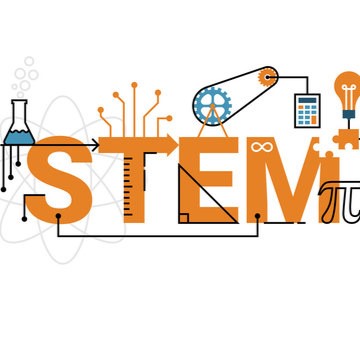 To meet our social and economic challenges with a STEM workforce, we need to improve the recruitment and retention of students with a STEM major in the university and job market. Current international research in school STEM education advocates integrated STEM (iSTEM) – i.e. inter- and trans-disciplinary, rather than multi-disciplinary approaches – for quality learning.
To meet our social and economic challenges with a STEM workforce, we need to improve the recruitment and retention of students with a STEM major in the university and job market. Current international research in school STEM education advocates integrated STEM (iSTEM) – i.e. inter- and trans-disciplinary, rather than multi-disciplinary approaches – for quality learning.
These challenges have been reflected in student entries for Hong Kong public examinations. Secondary school students prefer to study business and economics rather than science, advanced mathematics and technology, and there are no trends showing an increase in the number of students opting for STEM subjects. A strong and positive STEM interest and identity is a predictor of future study and career choice in a STEM field. A possible solution to the challenges is iSTEM programmes. However, existing studies of STEM education that address multiple disciplines seem insufficient, with mixed findings and inadequate direction for iSTEM advancement. Those studies in the development of STEM interest and identity have: (i) ignored the integrated nature of STEM, and focused on multiple disciplines; (ii) focused on equity, particularly underrepresentation by gender, race and language; and (iii) examined the effect of role models and mentors in the informal setting. As a result, we still understand little about how students develop their interest and identity in iSTEM classrooms. Literature suggests that Self-Determination Theory (SDT) provides an understanding of motivational processes that influence the development. Hence, this study employs the three psychological needs – autonomy, relatedness and competency – in SDT and the development of STEM interest and identity to propose an SDT approach to an iSTEM programme, by redesigning a non-SDT-based iSTEM programme: Hong Kong Sustainable City. It aims to investigate the effectiveness of the proposed 10-week programme on development, and understand how the three psychological needs support development. The study will employ a sequential explanatory mixed-method design study – an experiment with semi-structured interviews. Participants will comprise 300 Secondary Three students and 9 STEM teachers from three Hong Kong schools with different levels of academic achievement. Quantitative and qualitative analyses will be used to assess the study goals. Essentially, this study will significantly impact, in the short term, teachers and policymakers by enhancing their knowledge of STEM interest and identity, in the medium term, academia by contributing to the related theory and studies, and in the long term, the economy and society as a whole by improving student social mobility. |
||
On Health
Effects of a Decision Support Intervention on End-Of-Life Care Planning in Patients with Advanced Chronic Obstructive Pulmonary Disease and Their Family Members: A Mixed Method Approach Investigators: Helen Y. L. Chan (PI)*, Carmen W. H. Chan Yip, Vivian W. Lou, Pete Wegier, Jean Woo*, & Jacqueline K. Y. Yuen Funding source: Hong Kong Research Council – General Research Fund  Chronic obstructive pulmonary disease (COPD) is a highly prevalent progressive lifelimiting condition contributing to morbidity and mortality. Despite the anticipated changes along the disease trajectory, patients with advanced COPD and their family members generally are unprepared for end-of-life (EOL) situations due to unreceptive decisional stage, inadequate knowledge and understanding about treatment options, unrealistic expectations, unclear values, uncertainty and insufficient family or social support. While patients generally believe that their family members would be able to make the “right” decisions for them, evidence showed that, without prior open discussion, family members could hardly predict their sick relatives’ care wishes and they tended to make the decisions based on their own values.
Chronic obstructive pulmonary disease (COPD) is a highly prevalent progressive lifelimiting condition contributing to morbidity and mortality. Despite the anticipated changes along the disease trajectory, patients with advanced COPD and their family members generally are unprepared for end-of-life (EOL) situations due to unreceptive decisional stage, inadequate knowledge and understanding about treatment options, unrealistic expectations, unclear values, uncertainty and insufficient family or social support. While patients generally believe that their family members would be able to make the “right” decisions for them, evidence showed that, without prior open discussion, family members could hardly predict their sick relatives’ care wishes and they tended to make the decisions based on their own values.
Advance care planning (ACP) has been widely acknowledged as an empowerment process for enabling patients to make informed and value-based decisions for EOL care and communicating their care decisions with family and healthcare providers. However, evidence suggested that the narrative conversational approach has limited effects on EOL decision-making and family communication. Decision support interventions have emerged to support clinicians to provide information in a complete and balanced format and facilitate deliberation in a non-judgemental and impartial manner. However, such development for advanced COPD is under-researched. Therefore, this study seeks to support EOL decision-making in patients with advanced COPD and their family members. We adopt the Ottawa Decision Support Framework model to address their decisional needs for the difficult decisions in EOL care. We adopt an explanatory sequential mixed method approach to examine the study process and outcomes. A parallel two-arm single-blinded randomised controlled trial will be conducted to evaluate the effects of a specific ACP decision support intervention. A total of 226 dyads of patients with advanced COPD and their designated family members will be recruited from two hospital outpatient clinics. They will be randomly allocated to either the intervention group to receive the decision support intervention or the control group to receive general health coaching. Outcomes will be measured at baseline and 1- and 6-month post-allocation. Subsequently, a descriptive qualitative study will be conducted with a subsample of 30 dyads to explore how the intervention influenced the study outcomes. This study is timely to devise effective strategy to empower patients with advanced COPD and their family members in ACP. Findings of this study will provide insights into decisional needs for EOL decision-making among Chinese patients, family communication for ACP, and relevant service and policy development. |
||
Assessing the Impact of Possible Interventions against Extended-Spectrum Beta-Lactamases and Carbapenemases in Hong Kong Communities Using a Household Study and Mathematical Models Investigators: Kin-on Kwok (PI)* Funding source: Hong Kong Research Council – General Research Fund  Background
BackgroundAntimicrobial resistance (AMR) refers to antimicrobial drugs becoming ineffective in treating infections. The World Health Organization has recognized extended spectrum beta-lactamase producing Enterobacteriaceae (ESBL-E) and carbapenem-producing Enterobacteriaceae (CPE) as urgent and serious threats, and CPE is even rated as critical on the priority pathogens list for research and development. Their long duration of carriage after hospital discharge (ESBL-E: 6.6 months; CPE:387 days) and the potential of household transmission highlights the need for interventions to curb their spread into the community. In particular, the abundance of CPE in nearby Vietnam (52%) may foretell the potential endemicity of CPE in Hong Kong community. The application of mathematical epidemiology in the growing issue of ESBL-E and CPE is scarce. Up to 2016, there had only been four transmission modelling studies on ESBL-E and CPE. There is limited literature which depicts the hospital transmission and household transmission of these two bacteria empirically, and so far there is only one study to model the within-household transmission. Therefore, research gap in quantifying the transmission dynamics of ESBL-E and CPE between hospitals and households remains. Aims and methods This proposal integrates genomic and epidemiological data via a mathematical model. It aims to: (i) reveal patterns of household-hospital transmission of ESBL-E and CPE; and (ii) assess the effectiveness of possible interventions in reducing such transmission. It consists of (i) a household study; and (ii) a mathematical model. Expected results and implication The vision of this proposal is to support the infection control policy in reducing the spread of ESBL-E and CPE, with these scientific implications and public health values: (i) It is a pioneering work to establish the contribution of mathematical modelling to control ESBL-E and CPE among scant scientific evidence; (ii) It identifies key factors contributing to the spread of ESBL-E and CPE in households and hospital; (iii) It forecasts the trajectory of short- or long-term epidemics of ESBL-E and CPE in the community; and (iv) It informs the effectiveness of feasible interventions in reducing the transmission of CPE and ESBL-E. |
||
The Social Mobility of Young People in Hong Kong: An Analysis Based on Household Surveys Investigators: Victor W. T. Zheng*, Hua Guo*, & Kevin T. W. Wong Funding source: Policy Research @ HKIAPS  Young people have been the main supporters and participants in the recent social movements and protests in Hong Kong. Many have suggested that the reason for the anger of young people is the insufficient room for development and a lack of opportunities for upward mobility that they might be experiencing. However, there has been a lack of large-scale and reliable empirical research to confirm this. Thus, the purpose of this research is to explore the central concerns of young people in Hong Kong. Have the economic and social changes throughout the years deprived or hindered the upward mobility of young people? Have those changes resulted in injustice for them? Furthermore, the research aims to determine whether the continuous expansion of higher education has brought about the expected societal effects.
Young people have been the main supporters and participants in the recent social movements and protests in Hong Kong. Many have suggested that the reason for the anger of young people is the insufficient room for development and a lack of opportunities for upward mobility that they might be experiencing. However, there has been a lack of large-scale and reliable empirical research to confirm this. Thus, the purpose of this research is to explore the central concerns of young people in Hong Kong. Have the economic and social changes throughout the years deprived or hindered the upward mobility of young people? Have those changes resulted in injustice for them? Furthermore, the research aims to determine whether the continuous expansion of higher education has brought about the expected societal effects.
This research focuses on young and middle-aged individuals in Hong Kong and the analysis is conducted from three aspects. First, educational opportunities, which include access to university education and the role of tertiary education in career development. Second, opportunities in the economy, including job opportunities, chances for upward mobility, and the potential for increased income. Third, subjective social class, which refers to the subjective evaluation of their own social standing by young people in Hong Kong. This research consists of five main themes: 1. The relationship between family and intergenerational social mobility; 2. The relationship between gender and educational opportunities and occupational status; 3. The relationship between tertiary education and youth social mobility; 4. The relationship between elite universities, overseas degrees, and youth social mobility; 5. Social mobility opportunities for immigrants. The data used in this study was obtained from a thematic household survey conducted by the Census and Statistics Department of the HKSAR Government between November 2017 to July 2018. The survey successfully enumerated target respondents in some 10,000 households in accordance with a scientific sampling scheme. This research was supported by the Policy Innovation and Co-ordination Office and the Social Statistics Branch of the Census and Statistics Department of the HKSAR Government.
|
||
